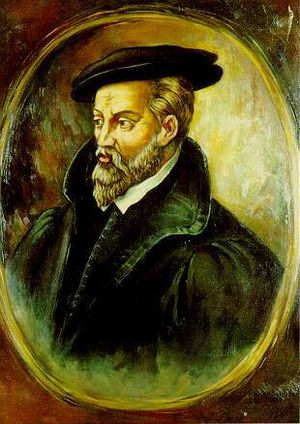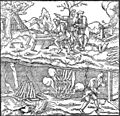Georg Agricola facts for kids
Georg or Georgius Agricola (1494-1555) was a German scholar and scientist. He was one of the first people to study mining and minerals (stones and gems). Because of his important work, he is often called the father of mineralogy.
Contents
Georg Agricola: The Father of Mineralogy
Georg Agricola was a very important scientist from the 1500s. He is famous for his detailed studies of mining and minerals. He wrote books that changed how people understood rocks, metals, and how to get them out of the ground. His work was based on careful observation, which was quite new for his time.
Early Life and Education
Georg Agricola was born in Glauchau, Germany, in 1494. His real name was Georg Bauer, but he later changed it to Agricola, which is Latin for "farmer." This was common for scholars back then. He started his education at the University of Leipzig when he was 20 years old. He studied many subjects, including Latin, Greek, and philosophy. After finishing his studies, he became a school principal, teaching these subjects.
A Doctor in a Mining Town
In 1527, Agricola moved to a town called Joachimsthal (now Jáchymov in the Czech Republic). This town was a busy mining center, famous for its silver mines. Agricola worked there as a town doctor. While he treated people, he became very interested in the mines and the work of the miners. He spent a lot of his free time visiting the mines. He watched how miners dug for ore, how they processed metals, and how they dealt with the challenges of working underground.
Studying Rocks and Metals
Agricola didn't just read old books about mining. He talked to miners, engineers, and smelters. He learned from their practical experience. He carefully observed the different types of rocks and minerals they found. He also studied the tools and methods used in mining. This hands-on approach was very unusual for scientists of his time. Most scholars preferred to study books rather than go out and observe the world directly. Agricola's detailed notes and observations helped him understand how minerals formed and how they could be used.
His Famous Book: De re metallica
Agricola's most famous work is a book called De re metallica. This Latin title means "On the Nature of Metals" or "About Things Metallic." He spent many years writing and illustrating this book. It was published in 1556, one year after he died. The book was a huge success because it was the first complete and systematic guide to mining and metallurgy (the science of working with metals).
De re metallica covered everything about mining. It described how to find mineral deposits, how to dig shafts and tunnels, and how to ventilate mines. It also explained how to process ores to get pure metals. The book included detailed drawings of mining tools, machinery, and processes. These illustrations were very helpful for people trying to understand the complex world of mining.
Agricola's Lasting Impact
Georg Agricola's work had a massive impact on science and industry. His book De re metallica became the standard textbook for mining and metallurgy for over 200 years. It helped miners and engineers improve their techniques and make mining safer and more efficient. He is considered the "Father of Mineralogy" because he was one of the first to classify minerals based on their physical properties. His scientific approach, based on observation and experience, helped lay the groundwork for modern geology and mineralogy.
Images for kids
-
Herodotus' Histories in Italian, translated by Count Matteo Maria Boiardo and published by the Aldine Press, Venice, (1533?)
See also
 In Spanish: Georgius Agricola para niños
In Spanish: Georgius Agricola para niños







